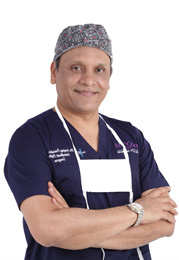Skin Grafting
Skin grafting is one of the most important types of cosmetic surgeries. This procedure involves removing healthy skin from a part of the body and transplanting it to another part of the body where the skin has been damaged. This is a very important type of reconstructive cosmetic surgery which is needed mostly after the skin has suffered damage from an injury, burn or illness.
What is the need for Skin Grafting?
Skin grafting is helpful in covering the parts of the body where the skin has been damaged. Some common reasons for getting skin grafts include,
- Severe burns
- Skin infections
- Bed sores/unhealed ulcers
- Large unhealed wounds
Different types of Skin Grafting techniques:
There are two main types of skin grafting procedures,
- Full-Thickness Grafts: Full-thickness grafts include removing muscles and blood vessels as well as the top two layers of the skin from donor site. Full thickness grafts are used for smaller sized wounds that are in an exposed part of the body, such as the face or hand. Full thickness grafts are able to blend in better with the surrounding skin and develops naturally.
- Split-level Thickness Grafts: Split-level thickness grafts involves removing only the two uppermost layers of the skin – the dermis and epidermis. These grafts are sourced from an area of the body which is not usually exposed and has healthy skin quality. Split level thickness grafts are ideal for covering larger area of damaged skin. However, these skin grafts are comparatively fragile with a characteristic smooth and shiny surface. They may also appear distinct from the surrounding original skin. These are purely superficial and do not develop naturally after grafting. Additional skin grafting might be required from time to time to replace the old grafted skin.
How is Skin Grafting procedure performed?
The skin grafting procedure is an intricate cosmetic surgery. The patient is usually administered general anesthesia to prevent any pain or discomfort during the procedure.
The surgery begins with the cosmetic surgeon removing healthy skin from the donor site. In case of split-level thickness graft, the surgeon will remove the skin from a part of the body which is covered and not usually exposed (such as the hip, inner thighs, etc). in case of a full thickness skin grafting procedure, the surgeon will usually remove healthy skin from the chest or abdomen.
Once the donor skin is harvested, the cosmetic surgeon will carefully place it over the recipient site. The skin graft is protected and secured with surgical dressing, stitches or staples. The surgeon will cover the donor area with a dressing to cover the wound.
What is recovery like after a Skin Grafting procedure?
The rate of recovery varies from individual to individual as it is dependent on different factors. In case of a split-thickness skin grafting procedure, the patient is usually required to recover in the hospital till the skin graft has taken hold properly. The blood vessels usually get connected to the skin within the first 3 days after the procedure.
A full thickness skin grafting requires a longer stay in the hospital, usually for a couple of weeks. There is also a need for rehabilitation (occupational/physical therapy) required after the skin has healed. Painkillers are prescribed for infrequent pain that might be felt. The surgeon will also give additional post-surgical advice on how to care for the graft and the donor site to prevent infection and other complications.
Skin grafting procedure is very helpful in restoring aesthetic normalcy to damaged skin in any part of the body. This is an effective and popular cosmetic surgical procedure aimed at improving the aesthetic aspects of the skin using the patient’s own donated skin graft.




